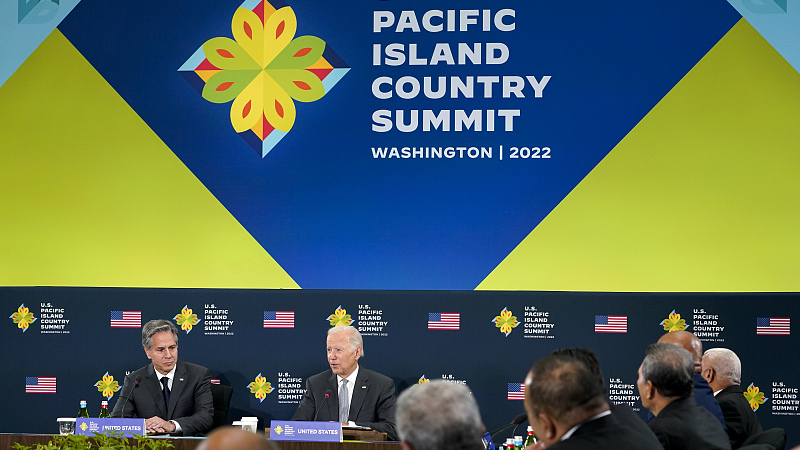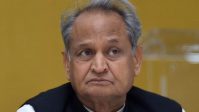- Published
- :
- October 2, 2022,
- 4:42 am
- |
- Updated
- :
- October 2, 2022,
- 7:14 PM
Joe Biden and Antony Blinken at the PIC Summit on 29 September.
The last two weeks have seen some of the most frantic US activity related to the Pacific Islands since the end of World War II. A lot happened. It’s like a plane suddenly dropped a cargo of randomly-sized boulders into a lake with varied depths. Some initiatives will sink, others may become essential islands of security in rough weather, some might inadvertently hit and sink the boats of allies.
Alexandria, Va.: Bear with me. This is a bit complicated. But it’s important. And, it’s not going away.
Over the past twenty years or so, the Chinese Communist Party has aggressively extended its tentacles across the planet. But for it to truly achieve the PLA Navy’s goal to break out of the First Island Chain—and in the process effectively push the US back across the Pacific to Hawaii—it needs influence, if not control, in a wide range of Pacific Island Countries (PICs).
The importance Beijing places on achieving influence in the PICs has been openly acknowledged at least since 2011, when Jian Yang—a former PRC spy school professor who later became a member of the New Zealand parliament—published The Pacific Islands in China’s Grand Strategy: Small States, Big Games.
From a Western strategic perspective, “management” of that challenge was largely delegated to Five Eyes members Australia and New Zealand. As the US withdrew into an “end of history” haze, closing embassies in places like the Solomon Islands—where so much American blood was soaked into the beaches during World War Two—Canberra and Wellington kept saying “don’t worry, we’ve got this covered”.
They didn’t.
When, earlier this year, pro-PRC Solomon Islands Prime Minister Manasseh Sogavare signed a security deal with Beijing that included provisions that allow for Chinese military deployment in the country for things like putting down internal dissent and protecting Chinese citizens and major projects, it got a lot harder to pretend that things were under control.
So, the US decided to “do something”.
The last two weeks have seen some of the most frantic US activity related to the Pacific Islands since the end of World War II. Key events included the September 13th Pacific Islands Conference of Leaders in Hawaii, the release of the US Institute of Peace’s report on China’s Influence on the Freely Associated States of the Northern Pacific, the publication of America’s first Pacific Islands Partnership Strategy, and a two-day summit in D.C. for over a dozen Pacific nations that culminated in a dinner with President Joe Biden and a joint declaration.
A lot happened. What does it mean? I’m really not sure yet. It’s like a plane suddenly dropped a cargo of randomly-sized boulders into a lake with varied depths. Some initiatives will sink and never be seen again, others may become essential islands of security in rough weather, some might inadvertently hit and sink the boats of allies. Time will tell.
What’s in the Strategy and the Declaration?
Just about everything. Climate, Ukraine, online gender-based violence, cyber, fisheries, Peace Corps, Quad, LGBTQI+, weather, submarine cables, health, unexploded ordinances, labour, trade, agriculture, tourism, supply chains, biodiversity, executive leadership training, and just about any other “rock” you think likely.
IMPLEMENTATION?
The broad idea behind implementation seems to be do some bilaterally, including via new embassies in Solomons, Kiribati, and Tonga, but also to coordinate efforts through another relatively new initiative, the Partners in the Blue Pacific (PBP), which consists of the United States, Australia, New Zealand, United Kingdom, Japan, Canada and Germany. And then filter a large section of that, and more, via the Pacific Island Forum (PIF), which the Strategy refers to as “core”.
This is where the cracks start to show. Throughout the rollout of these initiatives, US representatives have repeatedly spoken, often deferentially, about the role of Australia and New Zealand in shaping the approach.
National Security Council Indo-Pacific Coordinator Dr Kurt Campbell said he speaks to Australia and New Zealand almost every day. Australia and New Zealand were around throughout the meetings with Pacific Island leaders and, at the start of the Chamber of Commerce meeting with Pacific Leaders, New Zealand was specifically thanked by the hosts.
You can be sure that, as initiatives filter through the PBP and PIF, Australia and New Zealand will have a major hand in shaping engagement—and will expect to get benefits (this may explain why one of the outcomes was the US saying it would recognize Cook Islands and Niue as countries—in spite of citizens of both holding New Zealand passports, and raising some very complicated international law issues).
Second, while they consistently talk about the goal being economic and security integration with the Pacific Islands, they can’t even deliver for Pacific people in their own countries. In New Zealand, which regularly boasts of its self-declared special leadership role in the Pacific, 26% of children of Pacific ethnicity go without 6 or more of the 17 basic needs, compared to 11.3% for all New Zealand children.
Third, as regional colonial powers, they carry a ton of baggage. Imagine if, in the 1970s, the US was thanking the United Kingdom for their guidance at the opening of meetings with India.
Fourth, though there are many who know the issues and want to correct them, Australia and New Zealand seem to have a hard time correcting course.
Australian Foreign Minister Penny Wong consistently uses the term “Pacific family”. This reeks of condescension and ignores reality. In one small example, Australians assume they can walk in, visa-on-arrival, into any Pacific Country, but they make Pacific Islanders pass health, police and employment tests (show tax returns) to apply to come to Australia. That’s like a family member who demands you leave your door unlocked so they can come raid your fridge at any time, but you aren’t allowed in their house unless you beg—and even then sometimes just if you are useful to them (usually by doing things they don’t want to do themselves, like pick fruits).
Fifth, Australia and New Zealand aren’t really a factor in large sections of the Pacific, including the US Freely Associated States (Palau, Republic of Marshall Islands and Federated Stated of Micronesia).
For instance, President Whipps of Palau visited Japan on the way to Washington and had a two-hour one-on-one meeting with Prime Minister Kishida. Who do you think knows Palau better, Tokyo or Canberra?
I could go on, but you get the point, and I’d just get more annoyed.
No, wait, I can’t help it. Sixth. The dysfunctional relationship between Australia and New Zealand and some of the countries in the region has serious security implications. Solomons PM Sogavare is a master at playing Canberra, and using Canberra to play Washington.
One example, after Sogavare blocked a US Coast Guard ship from Solomons’ waters, he then blocked all naval ships from all countries except Australia and New Zealand (and one assumes China).
That made it look like Sogavare was playing ball (and could be “reasoned” with), and let Australia tell the US they had it under control. Actually, though, the US is still blocked from Solomons waters, and Australia has to cozy up to Sogavare to keep its “privileged” position.
Same thing happened in D.C. There was scuttlebutt that Sogavare wouldn’t sign the Declaration, but in the end he did—keeping hope (and his political career) alive. Meanwhile, Kiribati, the other PIC that flipped to China in 2019, has left the PIF and didn’t even show up for the summit. It is much closer to Hawaii and its exclusive economic zone covers as much of the planet as India. Not much being mentioned by Australia or New Zealand about that.
Seventh. No, I’ll spare you any more.
ISLAND LEADERS
At the same time, as all these rocks are thrown at the PICs, bear in mind that, in many cases, their ministries of foreign affairs might have a total of about a dozen people.
However, the region also has some of the best leaders on the world stage. While US and partners seem at times to be scrambling, PIC leaders—who have been at the center of geopolitical storms before—regularly support each other. In the Commerce meeting, Papua New Guinea spoke up about the importance of getting more flights for Palau. The wider group backed Marshall Islands on including language around nuclear testing issues in the Declaration.
And some of the strongest statements on China have come from leaders in the region (though not in the context of a PIF meeting).
This, for me, is where there is hope. As an example, one of the most clear-eyed statements coming from an American national on the issue that Pacific leaders say is their existential threat—climate change—came from Congresswoman Aumua Amata Coleman Radewagen, Member for American Samoa.
She said: “While China says the right things it does not do the right things—China is heavily reliant on coal power and the country is currently running 1,058 coal plants—more than half the world’s capacity.”
“I realize Beijing has made ample climate related funds available to Pacific countries with whom China has diplomatic relations but before you even think about negotiating any agreements with Beijing, you should be asking China to live up to international standards. They are not signatories to the Paris Climate Accord and although they say they are meeting international goals, their statistics are suspect. Our Pacific peoples and our governments need to deal with PRC at arm’s length with our eyes wide open.”
But the Congresswoman wasn’t at the summit in D.C. French Polynesia—a French territory—was there. But not Guam, Commonwealth of Northern Mariana Islands, American Samoa or Hawaii—the parts of the US that don’t “understand” the Pacific Islands as Australia and New Zealand claim they do, but ARE Pacific Islands.
And, for the US, the Freely Associated States are the closest friends a country could have—they have literally put their lives in the hands of Washington.
It would help all concerned if Washington started looking at the region not through the eyes of others, but through its own eyes. Then it might see it doesn’t have to throw random rocks and hope some stay above the water—it already has rocks in place, and now is the time to build bridges between them, and onwards.
Cleo Paskal is The Sunday Guardian Special Correspondent as well as Non-Resident Senior Fellow for the Indo-Pacific at the Foundation for the Defense of Democracies.







No comments:
Post a Comment